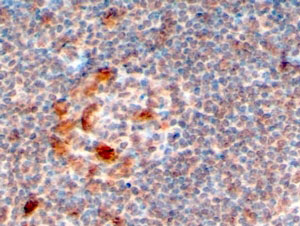ZCCHC11 / PAPD3 Antibody (C-Term)
Peptide-affinity purified goat antibody
- SPECIFICATION
- CITATIONS
- PROTOCOLS
- BACKGROUND

Application
| IHC, E |
|---|---|
| Primary Accession | Q5TAX3 |
| Other Accession | NP_001009881.1, NP_056084.1, NP_001009882.1, 23318 |
| Reactivity | Human |
| Predicted | Mouse, Rat, Dog, Cow |
| Host | Goat |
| Clonality | Polyclonal |
| Concentration | 0.5 mg/ml |
| Isotype | IgG |
| Calculated MW | 185166 Da |
| Gene ID | 23318 |
|---|---|
| Other Names | Terminal uridylyltransferase 4, TUTase 4, 2.7.7.52, Zinc finger CCHC domain-containing protein 11, ZCCHC11, KIAA0191, TUT4 |
| Format | 0.5 mg/ml in Tris saline, 0.02% sodium azide, pH7.3 with 0.5% bovine serum albumin |
| Storage | Maintain refrigerated at 2-8°C for up to 6 months. For long term storage store at -20°C in small aliquots to prevent freeze-thaw cycles. |
| Precautions | ZCCHC11 / PAPD3 Antibody (C-Term) is for research use only and not for use in diagnostic or therapeutic procedures. |
| Name | TUT4 (HGNC:28981) |
|---|---|
| Function | Uridylyltransferase that mediates the terminal uridylation of mRNAs with short (less than 25 nucleotides) poly(A) tails, hence facilitating global mRNA decay (PubMed:25480299, PubMed:31036859). Essential for both oocyte maturation and fertility. Through 3' terminal uridylation of mRNA, sculpts, with TUT7, the maternal transcriptome by eliminating transcripts during oocyte growth (By similarity). Involved in microRNA (miRNA)-induced gene silencing through uridylation of deadenylated miRNA targets. Also functions as an integral regulator of microRNA biogenesis using 3 different uridylation mechanisms (PubMed:25979828). Acts as a suppressor of miRNA biogenesis by mediating the terminal uridylation of some miRNA precursors, including that of let-7 (pre-let-7), miR107, miR-143 and miR-200c. Uridylated miRNAs are not processed by Dicer and undergo degradation. Degradation of pre-let-7 contributes to the maintenance of embryonic stem (ES) cell pluripotency (By similarity). Also catalyzes the 3' uridylation of miR- 26A, a miRNA that targets IL6 transcript. This abrogates the silencing of IL6 transcript, hence promoting cytokine expression (PubMed:19703396). In the absence of LIN28A, TUT7 and TUT4 monouridylate group II pre-miRNAs, which includes most of pre-let7 members, that shapes an optimal 3' end overhang for efficient processing (PubMed:25979828). Adds oligo-U tails to truncated pre- miRNAS with a 5' overhang which may promote rapid degradation of non- functional pre-miRNA species (PubMed:25979828). May also suppress Toll- like receptor-induced NF-kappa-B activation via binding to T2BP (PubMed:16643855). Does not play a role in replication-dependent histone mRNA degradation (PubMed:18172165). Due to functional redundancy between TUT4 and TUT7, the identification of the specific role of each of these proteins is difficult (PubMed:25979828, PubMed:25480299, PubMed:16643855, PubMed:19703396, PubMed:18172165) (By similarity). TUT4 and TUT7 restrict retrotransposition of long interspersed element-1 (LINE-1) in cooperation with MOV10 counteracting the RNA chaperonne activity of L1RE1. TUT7 uridylates LINE-1 mRNAs in the cytoplasm which inhibits initiation of reverse transcription once in the nucleus, whereas uridylation by TUT4 destabilizes mRNAs in cytoplasmic ribonucleoprotein granules (PubMed:30122351). |
| Cellular Location | Nucleus. Cytoplasm. Cytoplasm, Cytoplasmic ribonucleoprotein granule. Note=Mainly cytoplasmic (PubMed:19703396, PubMed:25480299). Translocates into the cytoplasm following treatment of the cell with LPS (PubMed:16643855). Co-enriched in cytoplasmic foci with MOV10 (PubMed:30122351) |

Thousands of laboratories across the world have published research that depended on the performance of antibodies from Abcepta to advance their research. Check out links to articles that cite our products in major peer-reviewed journals, organized by research category.
info@abcepta.com, and receive a free "I Love Antibodies" mug.
Provided below are standard protocols that you may find useful for product applications.
Background
This antibody is expected to recognize all 3 reported isoforms (as represented by NP_001009881.1; NP_056084.1; NP_001009882.1)
References
A novel Zinc finger protein, ZCCHC11, interacts with TIFA and modulates TLR signaling. Minoda Y, Saeki K, Aki D, Takaki H, Sanada T, Koga K, Kobayashi T, Takaesu G, Yoshimura A. Biochem Biophys Res Commun. 2006 Jun 9;344(3):1023-30.; Erratum
in: Biochem Biophys Res Commun. 2007 Feb 23;353(4):1121. PMID: 16643855
If you have used an Abcepta product and would like to share how it has performed, please click on the "Submit Review" button and provide the requested information. Our staff will examine and post your review and contact you if needed.
If you have any additional inquiries please email technical services at tech@abcepta.com.













 Foundational characteristics of cancer include proliferation, angiogenesis, migration, evasion of apoptosis, and cellular immortality. Find key markers for these cellular processes and antibodies to detect them.
Foundational characteristics of cancer include proliferation, angiogenesis, migration, evasion of apoptosis, and cellular immortality. Find key markers for these cellular processes and antibodies to detect them. The SUMOplot™ Analysis Program predicts and scores sumoylation sites in your protein. SUMOylation is a post-translational modification involved in various cellular processes, such as nuclear-cytosolic transport, transcriptional regulation, apoptosis, protein stability, response to stress, and progression through the cell cycle.
The SUMOplot™ Analysis Program predicts and scores sumoylation sites in your protein. SUMOylation is a post-translational modification involved in various cellular processes, such as nuclear-cytosolic transport, transcriptional regulation, apoptosis, protein stability, response to stress, and progression through the cell cycle. The Autophagy Receptor Motif Plotter predicts and scores autophagy receptor binding sites in your protein. Identifying proteins connected to this pathway is critical to understanding the role of autophagy in physiological as well as pathological processes such as development, differentiation, neurodegenerative diseases, stress, infection, and cancer.
The Autophagy Receptor Motif Plotter predicts and scores autophagy receptor binding sites in your protein. Identifying proteins connected to this pathway is critical to understanding the role of autophagy in physiological as well as pathological processes such as development, differentiation, neurodegenerative diseases, stress, infection, and cancer.


